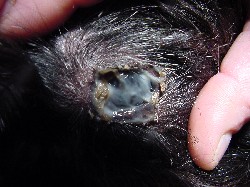Dry Eye or KCS
What is dry eye?
Dry eye (or keratoconjunctivis sicca, KCS) is usually due to a deficiency in the watery portion of tears. Tears are made by 2 glands around each eye - one above the eyeball and one in the third eyelid.
Less commonly, abnormalities of the oily or mucin (lipid) portions of the tears can occur. These components are made by the white part of the eye (conjunctiva) and glands on the eyelids.
What are the signs of dry eye?
Animals with dry eye usually have a very thick, mucous yellow-green eye discharge (see picture below - click to enlarge). When the dry eye occurs suddenly, ulcers can form on the cornea. The surface of the eye becomes inflammed leading to scarring, dark pigment deposits and blood vessel growth into the cornea on the surface of the eye.
What are the consequences of untreated dry eye?
Dry eye is potentially blinding and painful without treatment.
 What causes dry eye? What causes dry eye?
Dry eye can be caused by a variety of causes, but the most common cause is an autoimmune destruction of the lacrimal glands around the eye. Other causes include trauma, previous surgeries, certain drugs known to be toxic to the tear glands, infections (canine distemper, feline herpesvirus), neurological disorders, congenital disease and many other causes.
How is dry eye treated?
Dry eye treatment is individually tailored to each animal and may consist of some elements of the following medical treatments:
- Tear stimulators - these need to be given for at least 4 weeks before a response may be seen, but can be highly effective in animals with some remaining tear gland function. These drugs include cyclosporine and tacrolimus.
- Tear replacers - either ointment, gels or long-lasting drops are used to keep the eye moist
- Anti-inflammatories may be used to decrease the inflammation of the surface tissues on the eye
- Antibiotics - some dry eyes can develop secondary infections that warrant treatment.
Most animals respond to medical management. In the event that medical therapy fails, surgical transposition of their salivary duct to their eyes (parotid duct transposition) may be warranted. With this surgery, animals produce saliva tears whenever they eat a treat. This can be done to provide comfort and maintain vision for an animal with severe dry eye.
|